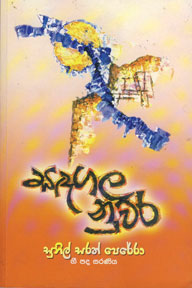Contemporary Sinhalese art song and lyricism
By Ranga CHANDRARATHNE
Art song is one of our most vital and
communicative musical genres – it flows and carries with it the language
of our changing times.
- Composer Libby Larsen
A song can be defined as ‘a piece of music performed by voice, with
or without instrumental accompaniment “or “a poem set to music”. Song is
one of the oldest forms of music. Signing styles and the writing styles
of lyrics differ among diverse cultures capturing social structures,
level of literacy, language and system of values.
Art song
Before dealing with contemporary Sinhalese art song, it is pertinent,
at least briefly, to examine the evolution of the modern art song.
 |
|
Sunil Satath Perera |
 The birth of modern Art song marks a seminal trajectory in the
evolution of song as a distinct art form. It primarily rejected two
popular notions in mid 16th century polyphony, more than one melody is
played or sung simultaneously. Firstly, it was believed that a given
piece of vocal music could be played at different time in any number of
alternative ways (Solo, ensemble or instrumental) and secondly the idea
that lyric is subordinate to music. The birth of modern Art song marks a seminal trajectory in the
evolution of song as a distinct art form. It primarily rejected two
popular notions in mid 16th century polyphony, more than one melody is
played or sung simultaneously. Firstly, it was believed that a given
piece of vocal music could be played at different time in any number of
alternative ways (Solo, ensemble or instrumental) and secondly the idea
that lyric is subordinate to music.
It was in the mid-16th century that a greater attention began to pay
on textual interpretation. Special rhythms were used to emphasise the
emotionally significant texts in polyphonic compositions. Though the
modern art song can be defined as “poet set to music”, it strives to
blend music and literature. It is based on four elements: poet,
composer, singer and accompanist. So the art song is the end result of
the combined effort of the four elements.
The composer of music uses his or her skills to embellish the lyric,
sometime, realising potential interpretations in the text. In a well
crafted art song, the composer creates a duet between the accompanist
and the vocalist to paint a picture that the lyricist has envisioned.
The performance of art song breathes life to the text through the
complementary and well coordinated partnership among the four elements.
The 17th century art song shows, among other things, the sensitivity of
the composer to the individual words, to the prosody and the overall
character of the text.
In 17th and 18th centuries, the singer, primarily, serves as the
prime interpreter of the text. It was during the 19th century that art
song reached its climax in expression, appreciation. Starting with
Schubert, the leading Romantic songwriters learned to exploit the device
of varying a strophic melody. The composer would use a basic musical
framework for each stanza but change voice and accompaniment details to
suit the progressing text. This concept eventually evolved into
through-composed songs with music well integrated into the text.
Evolution of Sinhalese art song
Sri Lanka has a long and well developed history of art song. However,
it was Munidasa Kumaratunga. The next phase of the evolution of art song
was by the lyricists like Chandrarathne Manawasinghe, Madawala S
Ratnayake, Ananda Samarakoon and Sunil Shantha.
The lyrics produced in the era were prominent for the diverse
experiments that the poet or lyricist carried out in writing the songs.
For instance, in Ananda Samarakoon’s songs such as Punchi Suda,
Sumano..Sumano , the lyricist has used of dialogue form effectively. It
was the Radio Ceylon or now SLBC which promoted art song through its
popular programmes such as Maduvanthi and song’s drama such as Manohari.
Mahagama Sekara’s programme ‘Maduvanthi “with W.D. Ameradeva was led to
fruitful outcomes in the Sinhalese Arts Song.
In the programme, experiments both in music and the structure of song
marked an important phase in the evolution of Sinhalese art song.
For instance, W.D Ameradeva did number of experiments with tune
motifs from folk poem while Mahagamasekara experimented with the
structure of the song.
It is obvious that a song will stand test of the time, only if it
contains philosophical thoughts which are universal.
It is this property which has made some of the songs immortal and
still popular. For instance, songs such as Irahada Payana Loke,
Sannaliyane and Sandekaluvara Galahalenavita are still widely
appreciated.
Use of Metaphor in song
Use of metaphor is one of the effective ways in which lyric is made
meaningful and philosophical. Usually in Sinhalese songs metaphors are
formed by fusing of nouns. However, Sunil Sarath Perera has formed
metaphor by the fusion of noun. For example, in his song Sanda Kaluvara
gala halenna vita , Sunil Sarath Perera has formed metaphors by the
fusion of noun and verb. Sanda Kaluvara gala halenna vita (gathering
darkness) and Senehasa Dalvunu Nivasa Soya Emi ( come in to the house
lit up with warmth ) are potent metaphors.
Oba ma samaga
Atinata ganna davasa
Me mahakanda
Baluva hinda gama sirasa
Oba ma atara
Wena nuwaraka giya vigasa
Me maha kanda baluva horahin madesa
(The song is about a painful separation of lovers and the time is
symbolised by the mountain. Time has devoured everything, its influence
on the peoples' lives and sense of impermanency is brought out in an
artistic manner)
The song Peradinayaka Ma Pemkala Youvatiya is one of the best lyrics
by Sunil Sarath Perera. At a glance, though the song is sounded a mere
reporting, the song explores the theme of impermanency and changes that
will be brought out by time. Symbols such as sun, moon have been aptly
used to indicate the change of time which has made the young girl the
poet loved in his youth a middle aged woman. Sunil has used the metaphor
' Noka nobi duk vinda attitaya ' ( miserable past) ascribing that it was
the past which suffered not the narrator. It is obvious from the lyrics
by Sunil Sarath Perera that a budding lyricist should have a
comprehensive understanding of the tradition which has been enriched by
veteran lyricists.
Although there are no specific set of rules as to how a novice should
pen a song, it is imperative for a budding lyricist to conduct
self-study on the existing body of lyrics and the linguistic and
literary strategies employed by veteran lyricists such as Mahagama
Sekara, Chandrarathne Manawasinghe and Madawala S Ratnayake.
In order to study the lyrics, an essential requirement is to have
lyrics of art songs in print. However, it should be mentioned here that
breaking down paragraphs into lines would not make songs. The basis of
art song is literature. Therefore, it is essential that due recognition
for such songs which enlighten the listeners apart from entertaining
them be accorded by way of awards. Veteran lyricist Sunil Sarath
Perera's latest contribution to the growing body of his lyrics in print
is Sandagala Nuwara which contains author's hitherto unpublished lyrics
on diverse themes.
A seminal publication
Sandagala Nuwara is a seminal publication in Sri Lankan literature on
songs on many counts. Besides author's earlier publications such as
Tunpath Rata, Padmatatakaya and Maha Kanda , Sandagala Nuwara offers
nineteen Art songs by the author which are result of meticulous
researched into art of lyric writing. The publication can be considered
as a guide book and object lessons for both budding and experienced
lyricists.
A significant aspect of the publication is that the lyrics presented
in the book manifest, among other literary qualities and rich in
philosophical thoughts, that the Sinhalese contemporary song is not
merely intended for cheap entertainment but an important medium through
which public taste can be uplifted. Sunil Sarath Perera is a lyricist
who firmly believes that the song is not a medium of cheap entertainment
and that philosophical thoughts can also be conveyed besides generating
zest through Art song. For instance, he has pointed out the secret
behind universal appreciation of songs by veteran lyricist such as
Mahagama Sekara, Sri Chandrarathne Manawasinghe S Ratnayake is the deep
philosophical thoughts that have gone into the lyrics.
The following song in Sandagala Nuwara exemplifies how a veteran
lyricist with deep understanding of life could incorporate philosophical
thoughts into an Art song.
Ra ra ra bombiye
Muvaveyan nangiye
Japan mandarin nadakara
Aurudu ayei handiye
Ujaruvata kiuvata lokate para kase
Dese hatiyata nomavey
Ena ena base
Sigiri katapath paure
Ata sangeete
Mihirata gamuko malliye
Seepada geethe
Auru aye handige
Muvaveyan malliyye
Kalen kaleta kiyavey
Nek nek baila
Desa basa rasa rakumata -nuwanin
Vada Karapalla
The underline message in seemingly reportage like popular song is the
overarching foreign cultural influence on contemporary society. The
lyricist has skilfully used a simple diction to highlight on adverse
alien cultural influence. The New Year celebration which is one of the
important cultural events has been taken as a site of change. Now,
instead of traditional celebrations of the New Year heralds to the sound
of Japanese music instruments and the celebration is at the junction.
The lyricist in simple diction conveys the message that the rich folk
music tradition is concealed in the poetry on the mirror wall of
Sigiriya rock fortress and that the young generation should take lead in
preserving traditions, folk music and languages.
This extremely popular Sinhalese song shows in no uncertain terms
that Art song can be used a conveyer of moral messages to the masses
while providing meaningful entertainments. Some of Sunil Sarath's songs
such as 'Mage Ratta Dalada Himi Saranai' is noted for arousing patriotic
sentiment albeit the song is dedicated to the sacred tooth relic of the
Buddha. Prominent characteristic of Sunil Sarath Perera's lyrics is that
they can be appreciated for their rich literariness.
It is obvious that through his lasting contribution to the Sinhalese
song, Sunil Sarath Perera has enriched the contemporary Sinhalese idiom.
For instance, in the song ' Thavath Udasanak" (Yet another morning),
Sunil has used metaphors such as ' Malak sema mitiyavata , pipi vane
udasanama' ( In the morning the valley is blossomed and swaying like a
flower).
In another way, what the poet says is that there is a valley full of
blossomed flowers which sway in the wind as if the valley itself sways.
Encoding such beautiful scenery in a metaphor shows the innate
ability on the part of the lyricist. The songs in Sandagala Nuwara is an
example art song which will stand the test of time. The future of the
Sinhalese art songs lies in the songs such as those by veteran lyricist
like Sunil Sarath Perera. |

